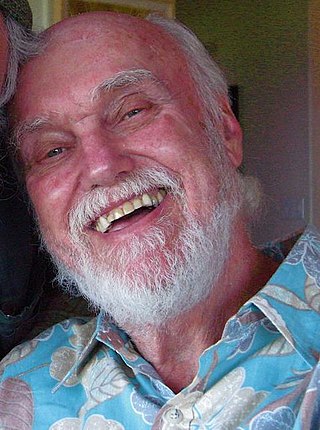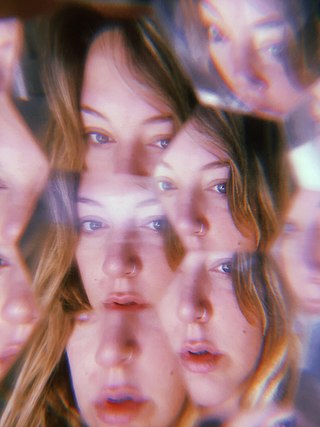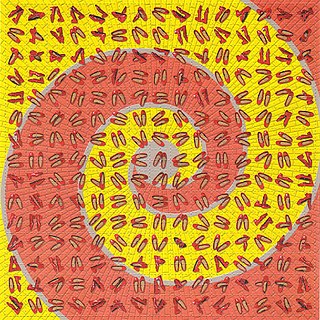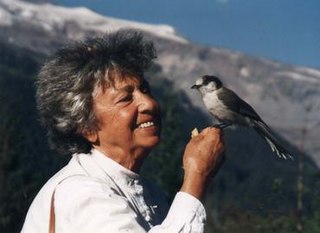
Timothy Francis Leary was an American psychologist and author known for his strong advocacy of psychedelic drugs. Evaluations of Leary are polarized, ranging from bold oracle to publicity hound. According to poet Allen Ginsberg, he was "a hero of American consciousness", and writer Tom Robbins called him a "brave neuronaut". During the 1960s and 1970s, Leary was arrested 36 times. President Richard Nixon described him as "the most dangerous man in America".

Ram Dass, also known as Baba Ram Dass, was an American spiritual teacher, guru of modern yoga, psychologist, and writer. His best-selling 1971 book Be Here Now, which has been described by multiple reviewers as "seminal", helped popularize Eastern spirituality and yoga in the West. He authored or co-authored twelve more books on spirituality over the next four decades, including Grist for the Mill (1977), How Can I Help? (1985), and Polishing the Mirror (2013).

The Bardo Thodol, commonly known in the West as The Tibetan Book of the Dead, is a terma text from a larger corpus of teachings, the Profound Dharma of Self-Liberation through the Intention of the Peaceful and Wrathful Ones, revealed by Karma Lingpa (1326–1386). It is the best-known work of Nyingma literature. In 1927 the text was one of the first examples of both Tibetan and Vajrayana literature to be translated into a European language and arguably continues to this day to be the best known.

Set and setting, when referring to a psychedelic drug experience or the use of other psychoactive substances, means one's mindset and the physical and social environment in which the user has the experience. Set and setting are factors that can condition the effects of psychoactive substances: "Set" refers to the mental state a person brings to the experience, like thoughts, mood and expectations; "setting" to the physical and social environment. This is especially relevant for psychedelic experiences in either a therapeutic or recreational context.

The psychedelic drug lysergic acid diethylamide (LSD) was first synthesized on November 16, 1938, by the Swiss chemist Albert Hofmann in the Sandoz laboratories in Basel, Switzerland. It was not until five years later on April 19, 1943, that the psychedelic properties were found.
The Psychedelic era was the time of social, musical and artistic change influenced by psychedelic drugs, occurring from the mid-1960s to mid-1970s. The era was defined by the proliferation of LSD and its following influence in the development of psychedelic music and psychedelic film in the Western world.

The Harvard Psilocybin Project was a series of experiments aimed at exploring the effects of psilocybin intake on the human mind conducted by Timothy Leary and Richard Alpert. The founding board of the project consisted of Leary, Aldous Huxley, David McClelland, Frank Barron, Ralph Metzner, and two graduate students who were working on a project with mescaline.

Ralph Metzner was a German-born American psychologist, writer and researcher, who participated in psychedelic research at Harvard University in the early 1960s with Timothy Leary and Richard Alpert. Metzner was a psychotherapist, and Professor Emeritus of psychology at the California Institute of Integral Studies in San Francisco, where he was formerly the Academic Dean and Academic Vice-president.

Bruce Jay Ehrlich, better known by his pen name Bruce Eisner, was an American writer, psychologist, and counterculture spokesman mostly known for his book Ecstasy: The MDMA Story.

The Concord Prison Experiment, conducted from 1961 to 1963, was designed to evaluate whether the experiences produced by the psychoactive drug psilocybin, derived from psilocybin mushrooms, combined with psychotherapy, could inspire prisoners to leave their antisocial lifestyles behind once they were released. How well it worked was to be judged by comparing the recidivism rate of subjects who received psilocybin with the average for other Concord inmates.
Michael Hollingshead (?–1984?) was a British researcher who studied psychedelic drugs, including psilocybin and LSD, at Harvard University in the mid-20th century. He was the father of comedian Vanessa Hollingshead. He evangelized the use of LSD to many notable figures.

High Priest is a 1968 book by American psychologist and writer Timothy Leary, published by New American Library. Written before Leary's incarceration on drug-related charges, it is an autobiographical account of his experiences from 1959 to 1962, a period that roughly coincides with his employment as a lecturer in clinical psychology at Harvard University.
Ego death is a "complete loss of subjective self-identity". The term is used in various intertwined contexts, with related meanings. Jungian psychology uses the synonymous term psychic death, referring to a fundamental transformation of the psyche. In death and rebirth mythology, ego death is a phase of self-surrender and transition, as described by Joseph Campbell in his research on the mythology of the Hero's Journey. It is a recurrent theme in world mythology and is also used as a metaphor in some strands of contemporary western thinking.

USCO was an American media art collective in the 1960s, founded by Gerd Stern, Michael Callahan, Steve Durkee, Judi Stern, and Barbara Durkee in New York. The name USCO is an acronym for Us Company or the Company of Us. The collective was most active during the years 1964–66. USCO exhibited in the United States, Canada, and Europe, and is considered a key link in the development of expanded cinema, visual music, installation art, multimedia, intermedia, and the Internet. In addition, USCO's strobe environments heralded new media art.

League for Spiritual Discovery (LSD) was a spiritual organization inspired by the works of Timothy Leary, and strove for legal use of lysergic acid diethylamide (LSD) for the purpose of meditation, insight, and spiritual understanding. It was in existence during the mid-to-late 1960s, and eventually closed by Leary. The New York Center for the League of Spiritual Discovery, in existence for around a year, was co-founded by Timothy Leary and Nina Graboi in 1966. The center was the first LSD-based meditation center in Manhattan.

The Psychedelic Experience: A Manual Based on The Tibetan Book of the Dead is a 1964 book about using psychedelic drugs that was coauthored by Timothy Leary, Ralph Metzner and Richard Alpert. All three authors had taken part in research investigating the therapeutic potential of psychedelic drugs such as LSD, psilocybin and mescaline in addition to the ability of these substances to sometimes induce religious and mystical states of consciousness.
The following is a list of works by Timothy Leary. The majority of Leary's works were put into the public domain by his estate in 2009.
The Hitchcock Estate in Millbrook, New York is a historic mansion and surrounding grounds, associated with Timothy Leary and the psychedelic movement. It is often referred to in this context as just Millbrook; it is also sometimes called by its original name, Daheim.

Nina Graboi was a Holocaust survivor, artist, writer, spiritual seeker, philosopher, and influential figure in the sixties psychedelic movement. After fleeing the Nazis in Europe and spending three months in a detention camp in North Africa, she and her husband came to United States as refugees. As a close friend and colleague of Timothy Leary's and Richard Alpert's, she was co-founder and director of the League for Spiritual Discovery's New York Center during the psychedelic era. The center was the first LSD-based meditation center in Manhattan. She also worked closely with Jean Houston, Abraham Maslow, Stanley Krippner, and Alan Watts.
Entheogenic drugs have been used by various groups for thousands of years. There are numerous historical reports as well as modern, contemporary reports of indigenous groups using entheogens, chemical substances used in a religious, shamanic, or spiritual context.














